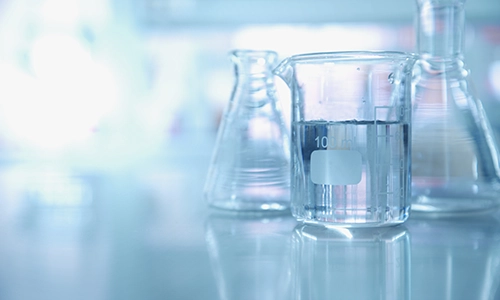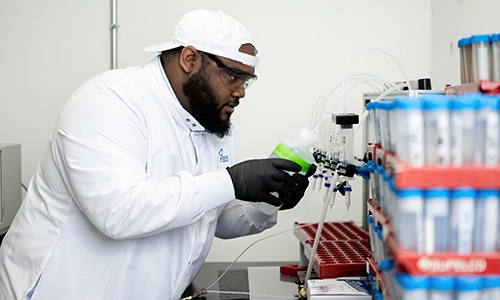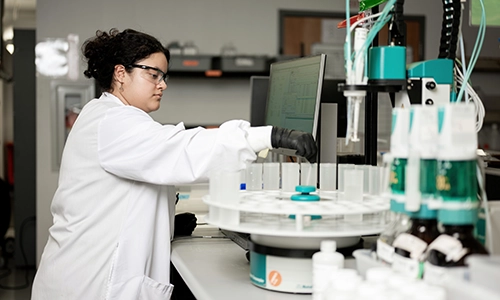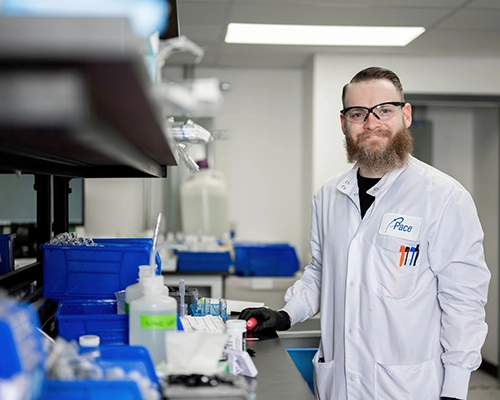Your Trusted Partner For Inorganics Testing And Analysis
Pace® provides a full range of metals and inorganic compounds testing services for a wide variety of industries, environmental consultants and engineers, municipalities, and property owners. Using the latest technology, as well as classic wet chemistry techniques, the inorganic laboratory routinely performs analyses on drinking water, wastewater, surface wipe samples, soils, and construction and demolition debris.
Services available include:
- Residues Analysis
- Anions
- Nutrients
- Cyanide
- Phenolics
- Hexavalent Chromium
- Total Organic Carbon
- TOX (Total Organic Halogens)
- Natural Attenuation Parameters and General Testing

What Is Inorganic Chemistry?
What Is Inorganic Analysis?
Inorganic analysis involves a variety of analytical methods that can qualitatively or quantitatively determine the inorganic and elemental composition of various contaminants in air, soil, water, biosolids, sediments, and tissues.


What Is Wet Chemistry?
Wet chemistry, also called wet chemical analysis, is a form of inorganic analytical chemistry that uses classical methods, such as colorimetry, gravimetry and titration, to analyze elements and compounds in liquid samples. It is called wet chemistry because most of the analyses are conducted with samples in a liquid phase.
Techniques For Inorganic Compound Detection
Titrimetric analysis is a method of analysis in which a solution of the substance being analyzed is treated with a solution of a suitable reagent of exactly known concentration. The reagent is added to the substance until the amount added is equivalent to the amount of substance to be determined.
Photometry is a method of measuring aqueous solutions using a light source to determine the amount of analyte present in a liquid. It has a wide range of industrial applications, including identifying contaminants in drinking and wastewater, analyzing nutrients in soil, determining building material composition, and more.
Spectrophotometry is a type of photometry that measures light based on its wavelength within a specific range. In this process, a spectrophotometer determines the amount of light that passes through or reflects at each wavelength, providing numerical values for various wavelengths. These instruments are commonly used in laboratories to perform broad spectrum scans as well as selective scans.
Gravimetric analysis measures the quantity of a substance by isolating it through selective precipitation from a water-based solution. After separating the precipitate from the remaining solution through filtration, it is weighed to determine its exact amount. All variations of this method involve manipulating the analyte's phase to separate it in its purest form and provide accurate quantitative measurements.
The process of chromatography involves separating components of a mixture. This is done by dissolving the mixture in a mobile phase and transporting it through a stationary phase. By altering the various phases, a wide variety of chromatographic methods have been created, each serving a different purpose and ideal for different mixtures. These include gas, liquid, thin layer, and ion exchange chromatography.

How Are Inorganics Regulated?
Today, inorganics are covered by a wide range of state and federal regulations to protect human health and natural resources from toxicity of these metals. Many of the primary programs are covered below.

Enacted in 1976, RCRA governs the disposal of solid and hazardous waste, including certain inorganic compounds such as antimony oxide, ferric chloride, and titanium dioxide. RCRA also monitors a group of eight heavy metals commonly referred to as the RCRA 8: Arsenic (As), Barium (Ba), Cadmium (Cd), Chromium (Cr), Lead (Pb), Mercury (Hg), Selenium (Se), and Silver (Ag).
The SDWA gives the U.S. EPA the authority to set National Primary Drinking Water Regulations (NPDWR) and enforce limits on contaminants in drinking water. The chemical contaminants rules regulate over 65 contaminants that include nitrate and arsenic as well as metals such as lead, copper, selenium, barium, and mercury.
The federal Clean Water Act (CWA) sets standards for surface water and makes it unlawful to discharge pollutants into the Waters of the United States unless approved through a special permitting process. Surface water, the receiving water for discharged wastewater, is monitored to ensure it does not contain contaminants higher than CWA standards. Federal law requires a review of water quality standards every three years. State laws may require more frequent reviews. The CWA also regulates how dredged or fill material may be deposited into lakes, wetlands, streams, rivers, and estuaries.
The National Pollutant Discharge Elimination System (NPDES) was established in 1972 by the Clean Water Act (CWA) to regulate the release of pollutants into U.S. waters. This permitting program covers point source emissions of inorganic compounds such as metals, including those from industries and wastewater treatment plants. Permits issued under the NPDES system help identify and control these discharges. Any discharge into a water body without a permit is illegal.
The Comprehensive Environmental Response, Compensation, and Liability Act (CERCLA), sometimes referred to as Superfund, is designed to remedy threats from unexpected releases and historical mistakes in hazardous waste management. CERCLA regulates the cleanup of abandoned hazardous-waste sites as well as accidents, spills, and other emergency releases into the environment, including inorganic compounds such as metals that are present.
Pace® Supports Your Environmental Project Needs
Inorganics identification is often needed for environmental remediation planning. The most commonly occurring inorganic soil contaminants are trace elements and radionuclides. Pace® supports lab testing needs required prior to soil remediation.
The Safe Drinking Water Act gives the EPA authority to regulate contaminants in drinking water, including inorganic chemicals such as arsenic. Many states have also set their own limits. Pace® is an EPA-approved lab for drinking water and credentialed in every state with a drinking water lab accreditation program.
Stormwater runoff is another type of wastewater discharge that may be covered by NPDES permitting requirements. As stormwater washes over natural and artificial ground and through metal pipes, it can easily pick up inorganic contaminants.
Inorganic contaminants are often a result of leaching from a contaminated source such as waste disposals mine-tailing, industrial production, and manufacturing sites. The contaminants from these sites will migrate with the flow of ground or surface water, creating a plume of dissolved phase-contaminated water.
A Nationally Recognized Leader For Inorganics Testing
The analysis of inorganic analytes in the environment covers a vast array of contaminants. Pace® provides a wide range of inorganic testing services with defensible results that can be used for a variety of purposes, such as compliance, environmental site assessments, forensics, employee health and safety, and risk management. Our highly skilled scientific staff uses the latest instrumentation and specializes in the determination and characterization of inorganic contaminants and trace metals in air, soil, water, biosolids, sediments, and biota (plant and animal tissues).
Additional Resources
Need to find a lab that can handle your unique requirements?
Contact us directly or download our list of environmental certifications across our network.